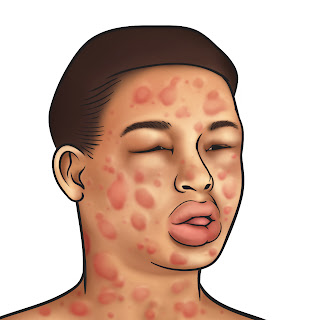Clinical Manifestations of Anaphylaxis
Clinical manifestations of anaphylaxis vary greatly. In the clinic, there are 3 types of anaphylactic reaction, which is a rapid reaction that occurs a few minutes to 1 hour after exposure to the allergen; moderate reaction occurs between 1 and 24 hours after exposure to allergens, as well as the slow reaction occurs more than 24 hours after exposure to the allergen.
Symptoms may begin with symptoms of new prodormal become severe, but sometimes heavy straight. Based on the degree of complaints, anaphylaxis is also divided into mild, moderate, and severe. Often with symptoms of mild peripheral tingling, warm sensation, tightness in the mouth, and throat. It can also happen nasal congestion, periorbital swelling, pruritus, sneezing, and watery eyes. Onset of symptoms began within the first 2 hours after exposure. The degree is being able to cover all mild symptoms plus bronchospasm and laryngeal edema or airway with dyspnea, cough and wheezing. Facial redness, warm, anxiety, and itching are also common. Onset of symptoms similar to a mild reaction. The degree of weight has a very sudden onset with signs and symptoms similar to those mentioned above along with a rapid progress towards bronkospame, laryngeal edema, severe dyspnea, and cyanosis. Can be accompanied by symptoms of dysphagia, abdominal cramps, vomiting, diarrhea, and convulsions. Cardiac arrest and coma are rare. Death can result from respiratory failure, ventricular arrhythmias or an irreversible shock.
Symptoms can occur immediately after exposure to the antigen and can occur in one or more target organs, such as cardiovascular, respiratory, gastrointestinal, skin, eyes, central nervous system and the urinary system, and other systems. Complaints are often found in the beginning phase is fear, soreness in the mouth, itchy eyes and skin, heat and tingling in the limbs, spasms, hoarseness, nausea, dizziness, weakness and abdominal pain.
In there eyes include conjunctival hyperemia, edema, eye discharge excessive. In allergic rhinitis, allergic shiners can be found, the area below the inferior palpebral dark and swollen. Examination of the nose out in the field there are some signs of allergies, such as: allergic salute, the patients using the palm of the hand rub his nose upward to relieve itching and relieving blockages; allergic crease, transverse skin folds due to the nose; later allergic facies , consisting of mouth breathing, allergic shiners, and teeth abnormalities. The interior of the nasal mucosa examined to assess the color, number, and shape of secretions, edema, nasal polyps, and septal deviation. On the skin are erythema, edema, itching, urticaria, skin feels warm or cold, damp / wet, and diaphoresis.
In the respiratory system occurs hyperventilation, decreased pulmonary blood flow, decreased oxygen saturation, increased pulmonary pressure, respiratory failure, and decreased tidal volume. Upper respiratory tract can be impaired if the tongue or oropharynx involved resulting in stridor. Hoarse voice could not even vote at all if edema continues to deteriorate. Complete airway obstruction is the most frequent cause of death in anaphylaxis. Wheezing breath sounds occur when the lower respiratory tract disrupted as bronchospasm or mucosal edema. In addition, a cough, nasal congestion, and sneezing.
Confused and agitated state followed by a decrease in consciousness to occur coma is a disorder of the central nervous. In the cardiovascular system hypotension, tachycardia, pallor, sweating, signs of myocardial ischemia (angina), endothelial leakage causing edema, accompanied by arrhythmia. While the kidneys, renal hypoperfusion resulting in decreased urine expenditures (oligouri or anuri) due to decreased GFR, which ultimately led to acute renal failure. Besides an increase in BUN and creatinine accompanied by changes in the electrolyte content of the urine.
Hypoperfusion on hepatobilier system, resulting in the central cell necrosis, elevated levels of liver enzymes, and coagulopathy. Symptoms that arise in the gastrointestinal tract as a result of acute intestinal edema and spasm of smooth muscle, such as abdominal pain, nausea, vomiting or diarrhea. Encountered sometimes rectal bleeding caused by intestinal ischemia or infarction.
Bone marrow depression that causes coagulopathy, platelet dysfunction, and DIC can occur in hematological system. While disturbances in neuroendocrine and metabolic systems, there is suppression of the adrenal glands, insulin resistance, thyroid dysfunction, and altered mental status. In a state of shock from aerobic metabolism changes to anaerobic resulting in increased lactic acid and pyruvate. Histologically cracks between cells, the cells swell, mitochondrial dysfunction, and cell leakage.
